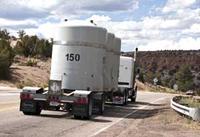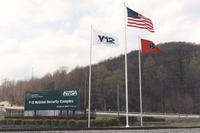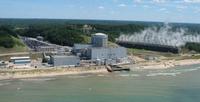-
Tetrapod robot developed for investigative, recovery work inside post-accident nuclear plants
Toshiba has developed a tetrapod robot able to carry out investigative and recovery work in locations which are too risky for people to enter; the multiple joints of its legs are controlled by a dedicated movement algorithm which enables the robot to walk on uneven surfaces, avoid obstacles, and climb stairs, securing access into areas which are challenging to be reached by wheeled robots or crawlers
-
-
Bottler wants to pump more water in Florida to send to Sandy’s victims, but the locals are angry
Niagara Bottling LLC Is attempting to boost the amount of water it pumps from the Floridan Aquifer in Central Florida to help victims of Hurricane Sandy, but it is unclear whether the help is needed
-
-
Building material of millennium: Autoclave Aerated Concrete

Although widespread rebuilding in the hard-hit New York metro region from Hurricane Sandy has not yet begun, New Jersey Institute of Technology (NJIT) scientists say when the hammers start swinging, it is time to look at autoclaved aerated concrete; the material, best known as AAC, has been heralded as the building material of the new millennium
-
-
Nuclear energy facilities proved themselves resilience during Hurricane Sandy

There are thirty-four nuclear energy facilities in the area hit by Hurricane Sandy; all of them have responded well and safely to the powerful storm; the industry says that careful planning and preparations days in advance of the storm paid off at all of these facilities
-
-
Hurricane Sandy offered support for reliance on nuclear power
A Scientific American writer is impressed with the way nuclear power facilities were able safely to withstand the wrath of Hurricane Sandy; the lesson he draws from this experience: “Global warming is increasing the probability and destructiveness of extreme weather events like Sandy. (I don’t see the point of dithering over this claim any more.) The last thing we should do in the face of this threat is abandon nuclear energy. If anything, we need more nuclear power, not less, to curb global warming”
-
-
Experts: German nuclear exit offers economic, environmental benefits
Following the accident at the Fukushima Daiichi Nuclear Power Station in 2011, the German government took the nation’s eight oldest reactors offline immediately and passed legislation which will close the last nuclear power plant by 2022; this nuclear phase-out had overwhelming political support in Germany; elsewhere, many saw it as “panic politics”; a new collection of studies shows that the nuclear shutdown and an accompanying move toward renewable energy are already yielding measurable economic and environmental benefits
-
-
U.K. govt. awards £37.1 million for civilian nuclear research
The U.K. Department for Business, Innovation and Skills has announced an award of 37.1 million pounds to the University of Sheffield’s Nuclear Advanced Manufacturing Research Center (Nuclear AMRC), which are working in partnership with Rolls-Royce as the lead company for the U.K. nuclear supply chain
-
-
Understanding the effects of Fukushima by studying fish
Japan’s “triple disaster,” as it has become known, began on 11 March 2011, and remains unprecedented in its scope and complexity; to understand the lingering effects and potential public health implications of that chain of events, scientists are turning to a diverse and widespread sentinel in the world’s ocean: fish; the data from Japan fisheries provide a look at how the ocean is faring eighteen months after the worst accidental release of radiation to the ocean in history
-
-
Twenty-year anniversary of U.S. last full-scale nuclear test
The first U.S. nuclear test, code named Trinity, took place in southern New Mexico forty-seven years earlier, on 16 July 1945; in all, the United States conducted 1,030 nuclear tests – the last one, code-named Divider, took place twenty years ago, on 23 September 1992
-
-
Los Alamos lab accelerates shipment of nuclear waste to permanent storage site

Los Alamos National Laboratory broke its own records in the first year of accelerated shipping effort of nuclear waste from the Lab to permanent disposal facilities located twenty-six miles outside of Carlsbad, New Mexico
-
-
Cosmic rays help gather information from inside the Fukushima nuclear reactors
Researchers have devised a method to use cosmic rays to gather detailed information from inside the damaged cores of the Fukushima Daiichi nuclear reactors which were heavily damaged in March 2011 by a tsunami that followed a great earthquake
-
-
U.S. keeps collecting money for a nuclear waste repository – but has no plans to build one
Illinois utility customers have paid the U.S government $1.9 billion to store spent nuclear fuel from nuclear plants in the state in a permanent national nuclear waste repository; in the last thirty years, the U.S. government has collected $30 billion from utilities toward this permanent storage, and it keeps collecting $750 million a year; trouble is, in February 2009 the Obama administration decided to “defund” the Yucca Mountain nuclear repository project, and the U.S. government no longer has active plans for a centralized nuclear waste storage facility
-
-
Y-12 Nuclear Complex’s uranium processing facility to be redesigned

Weeks after the inadequacy of security measures at the Y-12 Nuclear Complex came to light — an 82-year old nun and her two senior citizen colleagues eluded the facility’s fences and security to spend a few hours on the site’s grounds and spray-paint anti-nuclear slogans on its walls – criticism is directed at the design shortcomings of a new uranium processing facility; among other things, the roof of the new facility will have to be raised by thirteen feet because the designers did not take into account the size of the equipment the new facility will house
-
-
NRC sees no evidence of bad security practices at Michigan nuclear plant

The Nuclear Regulatory Committee (NRC) released information last week about a leak earlier this summer at the Palisades plant near South Haven, Michigan; the plant has been mired in controversy this year, as at least three water leaks have occurred in the past several months, and the plant has one of the worst safety ratings in the United States
-
-
Environmentalists concerned about earthquakes tests near California nuclear plant
The Pacific Gas and Electric Company (PG&E) wants to use air guns to emit strong sound waves into a large near-shore area which includes parts of marine reserves; the purpose: creating three dimensional maps of fault zones near its Diablo Canyon nuclear plant in California; the plans have federal and state officials concerned about marine life and public safety
-
- All
- Regional
- Water
- Biometrics
- Borders/Immig
- Business
- Cybersecurity
- Detection
- Disasters
- Government
- Infrastructure
- International
- Public health
- Public Safety
- Communication interoperabillity
- Emergency services
- Emergency medical services
- Fire
- First response
- IEDs
- Law Enforcement
- Law Enforcement Technology
- Military technology
- Nonlethal weapons
- Nuclear weapons
- Personal protection equipment
- Police
- Notification /alert systems
- Situational awareness
- Weapons systems
- Sci-Tech
- Sector Reports
- Surveillance
- Transportation
Advertising & Marketing: advertise@newswirepubs.com
Editorial: editor@newswirepubs.com
General: info@newswirepubs.com
2010-2011 © News Wire Publications, LLC News Wire Publications, LLC
220 Old Country Road | Suite 200 | Mineola | New York | 11501
Permissions and Policies
Editorial: editor@newswirepubs.com
General: info@newswirepubs.com
2010-2011 © News Wire Publications, LLC News Wire Publications, LLC
220 Old Country Road | Suite 200 | Mineola | New York | 11501
Permissions and Policies
